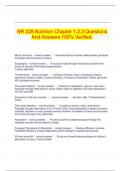NR 228 Nutrition Chapter 1,2,3 Questions
And Answers 100% Verified.
Mouth functions - correct answer. Secretes saliva enzymes called salivary amylase;
Formation and movement of bolus
Esophagus - correct answer. A muscular tube through which bolus travels from
mouth to stomach,Peristalsis,Segmentation
Cardiac sphincter
The Stomach - correct answer. Consists of fundus, body, and pylorus,Gastric
secretions, Gastric motility, Chyme formation, Functions of stomach, Pyloric sphincter.
HCl activates enzymes.
The small intestine - correct answer. Consists of duodenum, jejunum, and ileum
Passage through takes about 5 hours, Major organ of digestion and most absorption,
Villi and microvilli
Secretions in GI tract include..... - correct answer. Secretin, Bile, Cholecystokinin
(CCK)
The Large Intestine - correct answer. Consists of cecum, colon, and rectum,
Passage through takes about 9 to 16 hours, Site of final absorption of water and some
minerals, Bacteria in colon produce several vitamins. Formation of feces and excretion
from colon through anus (sphincter)
Absorption - correct answer. Process by which substances pass through the
intestinal mucosa into the blood or lymph
Transport Processes of Absorption - correct answer. Passive diffusion, osmosis,
Facilitated diffusion, Energy-dependent active transport, engulfing pinocytosis
Villi and microvilli - correct answer. Structure of small intestine allows for efficient
absorption to occur; "brush border"
, Which nutrients are easily absorbed regardless of level of need? - correct answer.
fats, carbohydrates, and protein
Factors that affect absorption - correct answer. Bioavailability, Relationship between
food and drug absorption
Nutrient transport systems - correct answer. Blood system, lymphatic system, liver
Elimination - correct answer. Expulsion of feces or body waste products called
defecation
Residue may include: - correct answer. Undigested materials such as cellulose and
other dietary fibers. Undigested fats may combine with dietary minerals such as calcium
and magnesium to form residue. Additional residue may include water, bacteria,
pigments, and mucus
Salivary Glands - correct answer. Saliva moistens and lubricates food, amylase
digests carbs
Gallbladder - correct answer. Stores and concentrates bile
Liver - correct answer. Breaks down and builds up many molecules. Stores vitamins
and iron. Destroys old blood cells, destroys poisons, produces bile to aid digestion.
Pancreas - correct answer. Hormones regulate blood glucose levels; Bicarbonate
will neutralize stomach acid.
Digestive process across the life span - correct answer. Allergies,Middle years
include gallbladder disease and peptic ulcers, Age-related lactose intolerance
Older years associated with constipation and diverticulosis
Metabolized - correct answer. Set of processes through which absorbed nutrients
are used by body for energy and to form and maintain body structures and functions.
Catabolism and anabolism
Catabolism - correct answer. the breakdown of food components into smaller
molecular particles, which causes the release of energy as heat and chemical energy.
Anabolism - correct answer. is the process of synthesis from which substances are
formed, such as new bone or muscle tissue.
Functions of nutrients - correct answer. Form new cell structures , Create new
substances such as hormones and enzymes, Assist in use of other nutrients in cell, Act
as catalysts or coenzymes in transforming and using of carbohydrates, proteins, and
lipids.
Provides energy




